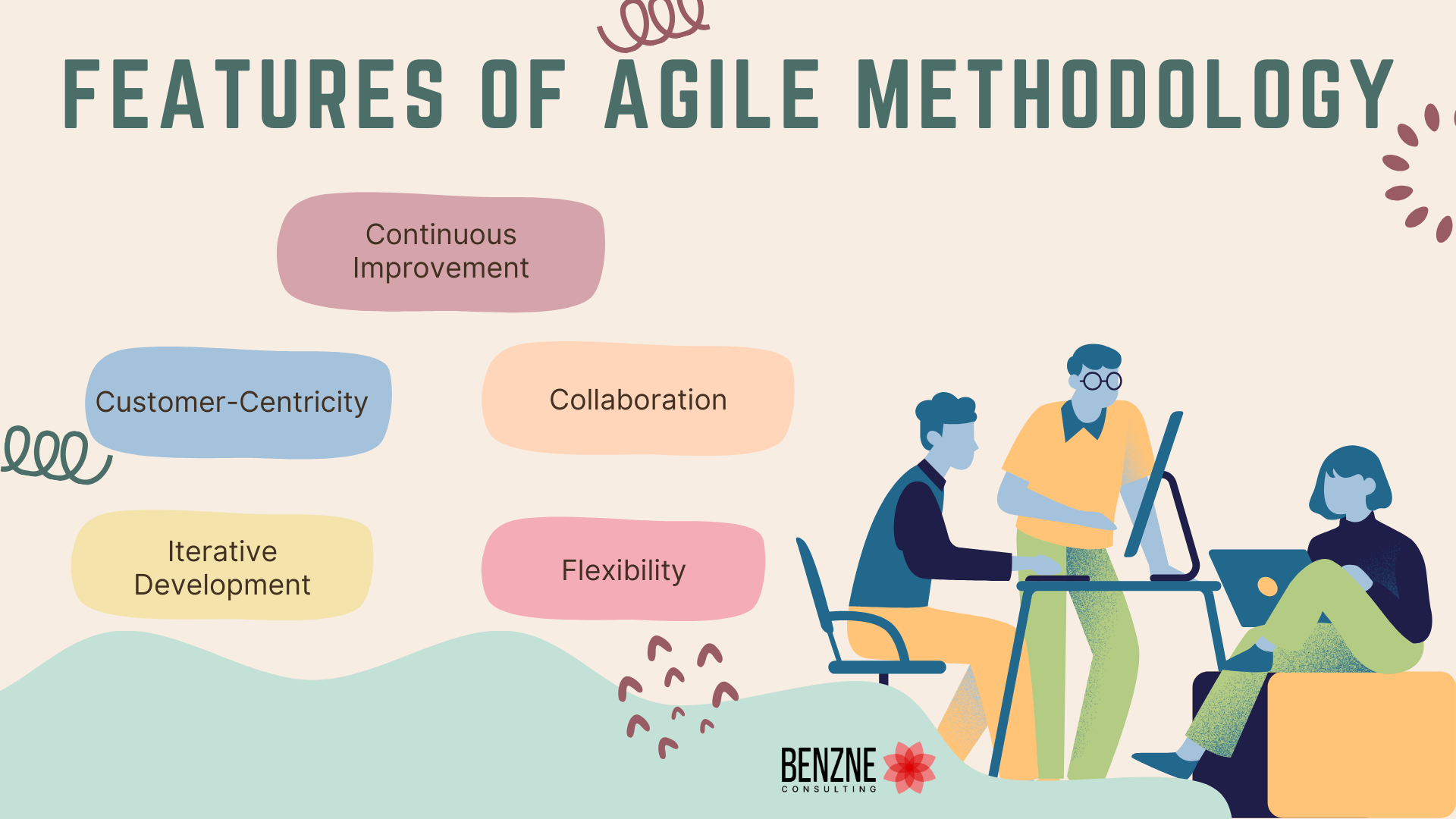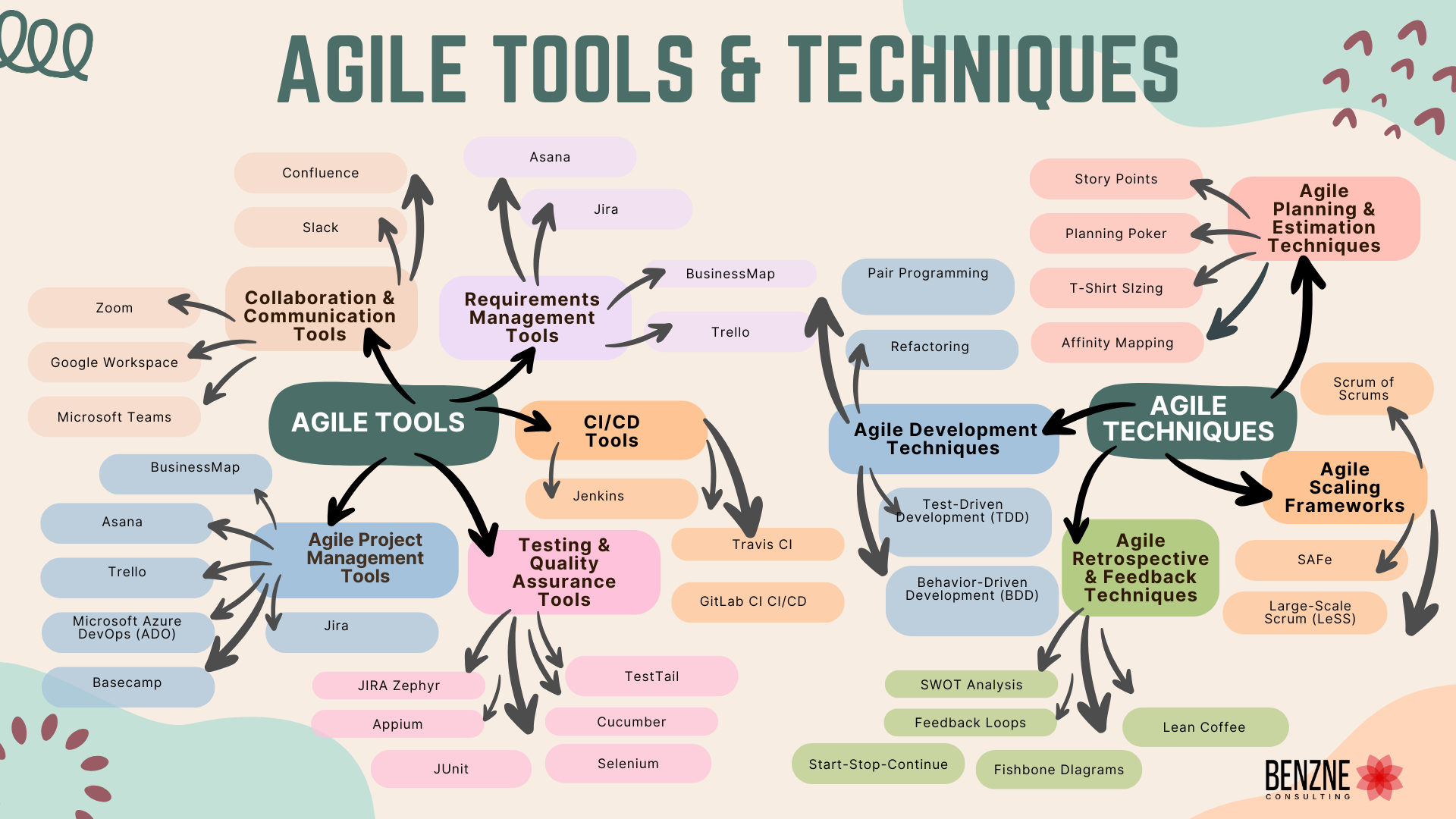Introduction to Agile Methodology Process
“Embracing uncertainty and embracing change is the heart of Agile.” — Jeff Sutherland
Prior to Agile, software development followed traditional Waterfall methods, characterized by rigid planning, linear execution, and limited customer involvement. Projects were often delayed, over-budget, and failed to meet customer expectations. Agile turned the traditional approach on its head, focusing on being nimble, collaborative and always striving for perfection. Agile emerged as a response to the need for faster time-to-market, better quality and increased customer satisfaction.
By adopting Agile, businesses benefit from accelerated delivery, reduced risks and improved responsiveness to change. Agile’s iterative approach enables teams to adapt quickly to shifting requirements, prioritize customer needs and deliver working software in shorter cycles. Ultimately, this boosts customer satisfaction, team efficiency and overall product excellence.
Businesses reap benefits such as reduced project costs, faster return on investment (ROI) and improved competitiveness in today’s rapidly changing market. By adopting Agile, companies can keep pace with change, innovate rapidly and consistently deliver value.
We will explore the below topics from our perspective in this blog:
- What is Agile Methodology?
- How is agile methodology process different from traditional processes?
- What are the main features of the agile methodology process?
- Key components of agile methodology process
- How to implement agile methodology and scrum process?
- What other frameworks can you explore for pursuing agility apart from agile methodology scrum process?
- What are a few important agile tools and techniques?
- How can consulting firms help you in agile process improvement?
- What are the key things to keep in mind while designing an agile methodology step by step process?
- A sample agile methodology step by step process for agile adoption
What Is Agile Methodology?
“The only constant in software development is change. Agile helps you adapt.” — Scott Ambler
Agile is a software development approach that emphasizes a mindset and culture of collaboration, flexibility, and continuous improvement. At its core, it is explained in Agile Manifesto which caters to 4 core values:
- individuals and interactions over processes and tools
- working software over comprehensive documentation
- customer collaboration over contract negotiation
- responding to change over following a plan
There are various frameworks that can help you bring agility like Scrum, Kanban, Lean, XP, DSDM, RUP, AUP, Crystal and many others.
This approach understands software development as a multifaceted process requiring perpetual learning, cross-functional teamwork, customer orientation and responsiveness to change.
Agile teams strive to create an environment where everyone feels empowered to contribute and make decisions, feedback is valued and acted upon, failures are seen as opportunities for growth, and continuous delivery and improvement are the norm. To achieve this, teams adopt various practices such as iterative development and delivery, regular feedback and retrospectives, continuous integration and testing, cross-functional teams and collaboration.
The benefits of Agile are numerous. By embracing this approach, teams can respond quickly to changing requirements, deliver high-quality software, foster a collaborative and innovative work environment and continuously improve and adapt. Additionally, Agile teams experience faster time-to-market, increased customer satisfaction, improved team productivity and morale and reduced project risks.
In essence, Agile is a mindset shift that enables teams to thrive in today’s fast-paced and ever-changing software development landscape.
What is the Agile Methodology Process?
The Agile method process consists of iterative cycles, continuous improvement and collaboration. It’s divided into focused areas that promote flexibility, customer satisfaction and team empowerment. Agile’s core values drive success:
- Customer-centricity puts users first,
- Collaboration fosters teamwork,
- Adaptability enables flexibility,
- Continuous improvement encourages learning and
- Transparency builds trust
These values create a culture that prioritizes people, communication and growth, resulting in faster delivery, higher quality and greater customer satisfaction.
Below is a step by step approach of bringing agility by applying agile methodology process in context of projects where scrum as a framework can be applied (A quick agile process implementation checklist):
1. Inception or Discovery
- Define project vision & goals
- Identify persona and understand them
- Define the As-Is and To-Be journey to identify the scope
- Identify stakeholders, their needs, and priorities
- Establish the Agile team and roles
- Create a product backlog (prioritized feature list)
- Estimate and identify the size of the scope
- Pre-Implementation readiness
2. Sprinting or Iterate
- Plan
- Identify the incremental goal
- Break down work into manageable tasks
- Prioritize tasks based on business value and complexity
- Assign tasks to team members
- Repurpose iteration goals and based on capacity
- Develop software in short cycles (sprints)
- Conduct daily stand-ups for team coordination
- Do
- Collaborate and work on assigned tasks
- Continuously integrate and test code
- Review
- Demonstrate working software to stakeholders
- Gather feedback and identify improvements
- Review iteration goals and progress
- Adapt and adjust priorities
- Retrospect
- Reflect on the iteration process
- Identify lessons learned and areas for improvement
- Implement process changes
- Repeat
- Plan for the next iteration
3. Ongoing Activities
- Deployment: Release working software to production
- Maintenance: Monitor and maintain software
- Feedback: Continuously gather user feedback
- Agile Artifacts
- Product Backlog: Prioritized feature list
- Sprint Backlog: Tasks assigned to the team
- Kanban Board: Visual representation of work
- Burn-down Chart: Tracking progress
- Velicity Chart: To track progress
- Cumulative flow diagram: To identify waste and building queue
- Control Chart: To monitor lead and cycle time
Agile Methodology Features

Imagine we are organizing a music festival.
One of the key features of agile methodology is Iterative Development. It is like planning the festival one stage at a time. Instead of coordinating the entire event simultaneously, the team focuses on booking performers for one stage, arranging logistics and then moves on to the next.
Flexibility comes into play when a main act is canceled last minute. The team adapts quickly, finding a replacement and adjusting the schedule.
Continuous Improvement is embodied by the team’s post-festival review or after an artist finishes performance. The team assesses what worked well, identifies areas for improvement and apply those lessons to improve the next edition of the festival.
Collaboration occurs seamlessly as sound engineers, stage managers, security personnel and performers work together, sharing expertise and communicating openly. We should establish the norms for the harmonious experience for all working together.
Customer-Centricity is prioritizing festival-goers’ experience. The team gathers feedback, monitors social media and incorporates suggestions to ensure an unforgettable experience. It also includes researching the experience of people ahead of them coming to the festival.
In Agile development, these principles work together like a well-orchestrated music festival. By breaking down work into manageable chunks, adapting to change, continuously improving, collaborating across functions, and prioritizing customer needs, Agile teams deliver successful events – or software solutions. These principles are the core of agile method process.
Key Components of the Agile Methodology Process
Following are the key components of Agile Methodology Process:
● Landscaping & defining Framework
- Various Agile methodology frameworks for team level agility like scrum, Kanban, XP or a combination of these needs to evaluated for fitment
- Scaling framework like SAFe provide configurations for organization level, Portfolio centric, Program or ART specific or just at the level of a team
- Few other popular scaling frameworks are LeSS, LeSS Huge, Nexus, DAD
● Practices that lead to purpose
- Product Discovery Identifying persona, Empathy Mapping, User Journey Mapping, Story Mapping, Backlog Creation, Estimation, Prioritisation
- Implementation Tool setup, Managing sprints, Visualizing progress on Kanban board, Events like Sprint planning, dailies and others
- Continuous improvement aspects like deployment strategy, automation, continuous integration, test driven development, refactoring and others
● Artifacts for seeking clarity, tracking progress and reporting
- Vision statement, roadmap, product backlog, sprint backlog, metrics like burndown chart, velocity chart, lead time, cycle time and others
● Role specific contributions to bring harmony and governance
- Product Owner, Scrum Master, Developers, Release Train Engineer (RTE), Solution Architects, Agile Coach and others
And this way we may see the various components that work in tandem to bring agility.
Implementing Agile Methodology
There can be many ways to formulate and design an agile methodology step by step process. Benzne as an Agile Consulting Company follows the below steps to design a Agile Transformation journey:
- Pre-Game
- Game
- Post-Game
‘Pre-Game’ includes understanding the need, conducting assessments, furnishing data driven insights post observations and interviews and proposing the way forward. At times, we conduct focused workshops just to course-correct based on finds and areas of improvement.
At ‘Game’, intent is to show results. Focusing on pilot projects helps us in exploring the gaps which might occur at a wider group and then figuring out ways to fix it so as to bring in elements of continuous delivery, failing faster, building increments and aiming to satisfy customers (and their customers) by delivering valuable outcomes constantly. If the scope of Gaming includes scaling then it becomes an integral part to cross-pollinate success stories by expanding the framework which has been earlier limited to piloting projects.
‘Post Game’ emphasizes more on bringing the trait of self-organization where we sustenance of goodness propagate through internal teams and we focus primarily on advisory services as the customer is matured enough to drive it on their own. In conclusion, when agility becomes a routine and the implementation provides the needful business benefits and satisfaction then it is time for us to pack our bags and leave with best wishes. 🙂
Agile Tools and Techniques
Tools are primarily used to simplify efforts and help us to expedite our implementation of agile method process. These Agile tools and techniques support Agile teams in planning, executing, and delivering high-quality software solutions. Let’s try to focus on essential tools and techniques that we see today in the market while introducing agile methodology. They are mapped against various needs:

- Agile Tools
- Agile Project Management Tools – Jira, BusinessMap, Asana, Trello, Microsoft Azure DevOps (ADO), Basecamp, VersionOne, Pivotal Tracker
- Collaboration and Communication Tools – Slack, Microsoft Teams, Google Workspace, Zoom, Confluence, Notion, Mural, Miro
- Requirements Management Tools – Confluence, Jira, BusinessMap, ADO, Trello, Asana, ProductPlan
- Testing and Quality Assurance Tools – Selenium, JUnit, TestRail, Cucumber, Appium, JIRA Zephyr
- Continuous Integration and Continuous Deployment (CI/CD) Tools – Jenkins, Travis CI, GitLab CI/CD, AWS CodePipeline, Azure DevOps
- Agile Techniques
- Agile Planning and Estimation Techniques – Story Points, Planning Poker, T-Shirt Sizing, Affinity Mapping, Velocity, WSJF
- Agile Development Techniques – Test-Driven Development (TDD), Behavior-Driven Development (BDD), Pair Programming, Refactoring, Continuous Integration
- Agile Retrospective and Feedback Techniques – Start-Stop-Co
- ntinue, Fishbone Diagrams, SWOT Analysis, Feedback Loops, Lean Coffee
- Agile Scaling Frameworks – Scrum of Scrums, Large-Scale Scrum (LeSS), SAFe (Scaled Agile Framework), Disciplined Agile Delivery (DAD)
How Consulting firms play a role in the Agile methodology process?
Unlocking agile transformation with agile transformation companies like Benzne Consulting empower organizations to achieve seamless agile adoption, amplifying business agility, customer satisfaction, and ROI. Our services that has created maximum impact to our customers who are looking for implementation of agile methodology are:
- Knowing the As-Is state by conducting Agile maturity Assessment, tailored evaluations to determine optimal Agile methodologies.
- Coaching support for Implementing agile at business & respective portfolio & program levels
- Expert guidance on framework at team/multi-team level by training and implementing Scrum, Kanban, and XP Implementation
- Advisory support
Following are the core benefits of partnership with Benzne Consulting:
- Enhanced Visibility by real-time project transparency
- Assuring Customer Delight through Iterative development and feedback
- Imbibing Adaptability by building responsive fabric to changing requirements
- Building Team Synergy by elevating collaboration and communication
- Creating quick success stories for cross pollination and leveraging agile at scale consulting for achieving business agility
We are often asked that how we overcoming challenges and here is our response:
- Resolve Change Resistance by implementing strategic change management approach
- Minimizing Communication Gaps by effective stakeholder engagement
- Continuous Success Measurement by introducing customized metrics and monitoring
By partnering with us, organizations who want to spearhead can accelerate Agile transformation, enhance their business outcomes and foster a culture of continuous improvement.
Conclusion
Embracing Agile methodology is crucial in today’s fast-paced business landscape. At Benzne Consulting, our expert Agile consultants empower organizations to achieve seamless Agile adoption, amplifying business agility, customer satisfaction and Return Over InvestmentI.
By leveraging Agile principles and practices, businesses can unlock faster time-to-market, enhanced customer satisfaction, improved team collaboration, and increased adaptability. Whether you’re just starting your Agile journey or seeking to refine your existing processes, our tailored solutions drive results. Contact us to learn more about our Agile consulting services and discover how Benzne Consulting can help you in your agile transformation journey.
Frequently Asked Questions About Agile Methodology Process
1. What are the 3 stages of Agile methodology?
Discover, Iterate & Continue.
Discover emphasizes primarily on knowing the ‘why?’ and for that we conduct visioning and goal setting workshops. It then leads to ‘For Whom?’, where we explore personas who are affected and will be impacted after the solution is provided. ‘How might we?’ helps us in identifying possible ways or solutions that could lead to resolution of problems. All in all, it helps us in ‘knowing’ about what we want to build.
Iterate emphasizes the ‘Doing’ aspect. Here, we apply a framework that fits well to the need of development and ensure just-enough feedback loops to learn the direction of development and satisfaction of customer needs.
Continue emphasizes on ongoing activities which are essential for software development.
2. What are the 12 principles of Agile methodology?
As per Agile Manifesto, the emphasize to bring agile is explained through these 12 agile principles:
- Prioritize customer satisfaction
- Embrace change
- Deliver working software frequently
- Foster collaboration
- Trust and motivate team members
- Communicate effectively
- Measure progress through working software
- Maintain sustainability
- Pursue technical excellence
- Emphasize simplicity
- Encourage self-organization
- Continuously improve
3. What is one of the most important first Agile Methodology process steps?
Usually, one of the first agile methodology process steps is always to gain a deep understanding of the problem and avoid any kind of assumptions and misconceptions. It is also important to learn potential constraints and limitations by empathizing with users and stakeholders when following an agile method process.
At Benzne Consulting, we focus on asking critical questions to ourselves when we are hired to solve the problems, instead of rushing to solve the problem or selling what we know. Few samples –
- What is the core problem we’re trying to solve?
- Who is affected by this problem?
- What are the root causes?
- What are the key pain points?
- What are the desired outcomes?
By sitting on the problem and not jumping to solutions, you ensure a solid foundation for your Agile project. This approach provides a clearer understanding of the problem, reduces risk of solving the wrong problem, and increases stakeholder alignment and more effective solution design.
Gain invaluable insights from agile consulting experts dedicated to streamlining your processes. We enhance collaboration and drive successful outcomes tailored to your unique challenges.

